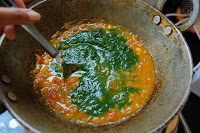Since our first trip to Pondicherry, I've been getting these insatiable cravings for idli-sambar and upma. These, along with the occasional dosa and rasam-chawal, are the only South Indian food obsession to which I can lay claim. Corner House next door takes well enough care of me when I want dosa, and rasam is simple to make at home, but ever since that trip, and our breakfast at Anand Bhavan on New Years day, I've been unable to get their upma out of my head.
My mother makes excellent upma. I can't say that I always liked it when I was growing up, but now having acquired a taste for it, and having eating enough upma from a variety of places, I can safely say that hers is one of the most delicious I've tasted. My mother-in-law makes it too, but often adds cashews and raisins, giving it a very Mughalai quality - if it's possible to describe upma as Mughalai. For me, the best will always be my mom's, and the ghee-laden version I had in Pondi. I've since managed to make a highly convincing knock-off at home using very few ingredients. Here is is:
Upma (serves 3-4)
Start of by heating the ghee on medium low in a kadai or wok. Add the mustard seeds, and then the curry leaves. The leaves should crackle on contact with the ghee. When they look crispy, add the chopped chilies and chopped onion. Stir the onions so they are evenly coated in ghee. After that, you can leave them alone until they become translucent. Now add the chopped tomato. Cook until the tomato pieces become soft, but not drippy or squishy.

Add the roasted sooji, and take care to mix it in properly with the ingredients cooking in the kadai. When everything is combined, start slowly adding the water; half-a-cup at a time should do the trick. The sooji will start to absorb the water, and swell. It usually takes twice its weight in water, and will double in quantity. This is also a good time to add the salt. The water will help it to evenly flavour the upma. The upma is done when all the water is absorb, and when the sooji has attained a mildly sticky and gooey consistency. The more it cools, the more congealed it will become, so be sure to eat it at the consistency you like best.
Some Variations
The above is my own very simple version of upma. A more authentic version will include 1 tsp each of urad dal and chana dal. These should be soaked overnight for easy cooking and should be added at the same stage as the onions. They will remain whole when the upma is done, but will be soft and easy to chew. Some variations also require finely chopped ginger to be added with the onion, and others still recommend a pinch of hing/asafetida when the mustard seeds are added, and you can even add a pinch of turmeric for colour.
Here's another quick hint: if you don't get ready roasted sooji, you can do it yourself. Add the sooji to the kadai without any oil or ghee. Keep stirring it on medium high until the grains darken a little in colour. They will also emit a slightly nutty full-bodied aroma. Keep the now roasted sooji aside, and go ahead with the upma. If you feel like it, you can always garnish with a little chopped coriander. Or, if you're feeling super creative, stuff the upma inside a roasted capsicum. It does wonders for the presentation. Bon appetit!





